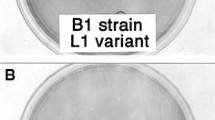Summary
The replication of Friend Leukemia virus (FLV) has been investigated in adhesive clones (FF) of Friend Leukemia cells which were selected via cultivation on top of human fibroblast monolayers. In these adhesive clones a shut-down of FLV production is observed under conditions of culture confluency; this finding is not due either to a reduced number of cell divisions nor to a defective expression of FLV genome as assessed by Northern blot and immunofluorescence studies. Ultrastructural studies showed that virus budding and release into the medium is not detectable under these conditions. Conversely, in confluent FF cell monolayers abundant imperfect type-A enveloped particles were visible, possibly originating from stacks of granular endoplasmic reticulum with thickened membranes.
It is postulated that the reduced virus production in adhesive FF monolayers is due to as yet undetermined events taking place during virus maturation at a time coincident with that of cell-cell adhesion under conditions of culture confluency.
Similar content being viewed by others
References
Hanafusa H (1977) In:Wagner RP, Fraenkel-Conrat H (eds) Comprehensive virology, vol 10. Plenum Press, New York, pp 401–483
Hynes RO (1973) Alteration of cell surface proteins by viral transformation and by proteolysis. Proc Natl Acad Sci USA. 70: 3170–3174
Vaheri A, Ruoslahti E (1974) Disappearance of a major cell-type specific surface antigen (SF) after transformation of fibroblasts by Rous sarcoma virus. Int J Cancer 13: 579–586
Yamada, KM, Yamada SS, Pastan I (1976) Cell surface protein partially restores morphology, adhesiveness and contact inhibition of movement to transformed fibroblasts. Proc. Natl Acad Sci USA 73: 12–17
Friend C (1978) The phenomenon of differentiation in murine erytroleukemic cells. Harvey Lectures, Series 72: 253–281
Yamasaki H, Weinstein IB, Fibach E, Rifkind RA, Marks PA (1979) Tumor promoter-induced adhesion of the DS 19 clone of murine erythroleukemia cells. Cancer Res 39: 1989–1994
Alan M, Harrison P (1980) Co-expression of differentiation markers in hybrids between Friend cells and lymphoid cells and the influence of the cell shape. Cell 19: 437–447
Demsey A, Grimley PM (1976) Characteristics of a surface-adherent sublines derived from FLC in continuous suspension culture. Cancer Res 36: 384–393
Benedetto A, Amici C, Djaczenko W, Zaniratti S, Santoro MG (1981) Role of fibronectin in the adhesion of Friend erythroleukemia cells. DMSO-induced production of hemoglobin in adherent flattened cells. Exp Cell Res 134: 219–229
Benedetto A, Amici C, Djaczenko W, Zaniratti S, Elia G (1982) Acquisition of sensitivity to exogenous fibronectin by Friend leukemia cells correlates with reduction of their tumorigenic potential. Int J Cancer 30: 663–667
Benedetto A, Amici C, Djaczenko W, Zaniratti S, Elia G (1985) Induction and maintenance of flattened morphology in highly adhesive Friend leukemia clones requires the time- and space-specific assembly of microtubolar networks. Int J Cancer 36: 591–599
Oliff AI, Hager GL, Chang EH, Scolnick EH, Chan HW, Lowy DR (1980) Transfection of molecularly cloned Friend murine leukemia virus DNA yields a highly leukemogenic helper-independent type C virus. J Virol 33: 475–486
Chattopadhyay Sk, Cloyd MW, Linemeyer DL, Lander MR, Rands E, Lowy DR (1982) Cellular origin and role of mink cell focus-forming viruses in murine thymic lymphomas. Nature 295: 25–31
Adams SL, Sobel ME, Howard BH, Olden K, Yamada KM, de Grombrugge B, Pastan I (1977) Levels of translatable mRNAs for cell surface protein, collagen precursors and two membrane proteins are altered in Rous sarcoma virus-transformed chick embryo fibroblasts. Proc Natl Acad Sci USA. 74: 3399–3403
Thomas PS (1980) Hybridization of denatured RNA and small DNA fragments transferred to nitrocelluse. Proc Natl Acad Sci USA. 77: 5201–5205
Rigby PWJ, Dieckmann M, Rhodes C, Berg P (1977) Labeling deoxyribonucleic acid to high specific activityin vitro by nick translation with DNA polymerase I. J Mol Biol 113: 237–251
Chouikh Y, Volovitch M, Yot P (1979) A simple and fast electrophoretic method for elution of nucleic acids from gels. Mol Biol Rep 5: 237–239
Author information
Authors and Affiliations
Additional information
With 7 Figures
Rights and permissions
About this article
Cite this article
Amici, C., Oppi, C., Fiorucci, G. et al. Reduced maturation of friend virus in adhesive mutants of friend leukemia cells. Archives of Virology 92, 151–164 (1987). https://doi.org/10.1007/BF01310069
Received:
Accepted:
Issue Date:
DOI: https://doi.org/10.1007/BF01310069




